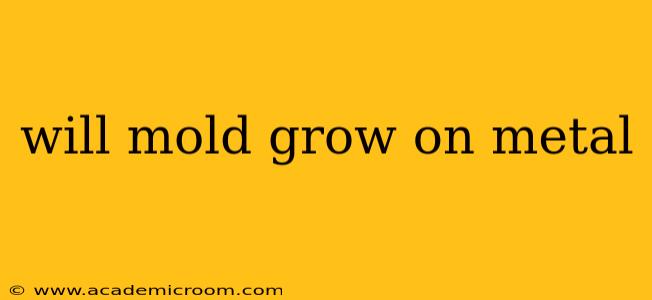Will Mold Grow on Metal? Understanding the Relationship Between Mold and Metal Surfaces
Mold, a type of fungus, thrives in damp, dark, and nutrient-rich environments. While it's less likely to grow directly on most metals compared to organic materials like wood or drywall, it's crucial to understand the nuances of this relationship. The answer, simply put, is: not directly, but indirectly, yes.
Let's delve deeper into the factors influencing mold growth on and around metal surfaces.
What Types of Metals Are Resistant to Mold?
Many metals, due to their inherent properties, are relatively resistant to mold growth. This is because mold needs a surface with organic matter to colonize and thrive. Metals like stainless steel, aluminum, copper, and galvanized steel are generally less hospitable to mold spores than porous materials. Their smooth, non-porous surfaces make it difficult for mold hyphae (the thread-like filaments of mold) to attach and establish themselves.
Can Mold Grow Near Metal?
While mold may not grow directly on the metal itself, it can absolutely grow near it. If there's moisture or organic material present in the vicinity of metal surfaces, mold can readily colonize those areas. Think about:
- Insulation around metal pipes: Mold often grows on the insulation surrounding metal pipes in damp environments because the insulation provides the necessary organic matter and moisture retention.
- Metal shelving with stored items: If items stored on metal shelving are damp or moldy, the mold will grow on the items, not the metal, but the proximity can create a larger problem.
- Condensation on metal surfaces: Condensation on cold metal surfaces can provide the moisture needed for mold growth on nearby surfaces, like drywall or wood.
What Conditions Favor Mold Growth Around Metal?
Several factors significantly contribute to mold growth near metal surfaces:
- High humidity: Excess moisture in the air creates a perfect breeding ground for mold spores.
- Poor ventilation: Lack of proper ventilation traps moisture, leading to mold growth.
- Presence of organic matter: Dust, dirt, food particles, or other organic debris provide the nutrients mold needs to survive.
- Temperature: Moderate temperatures (around 70-80°F or 21-27°C) are ideal for mold growth.
How to Prevent Mold Growth Near Metal Surfaces?
Prevention is always better than cure. Here’s how to minimize the risk of mold growth in areas with metal components:
- Maintain low humidity: Use dehumidifiers in damp areas.
- Ensure adequate ventilation: Improve airflow using fans or exhaust systems.
- Clean regularly: Remove dust and dirt frequently, particularly around metal surfaces.
- Address leaks promptly: Repair any leaks or water damage immediately to prevent moisture buildup.
- Inspect regularly: Periodically check for signs of mold, paying close attention to areas around metal pipes and fixtures.
Does the type of metal matter in mold prevention?
While some metals are inherently more resistant to mold, the type of metal isn't the primary factor in preventing mold growth. The surrounding environment and the presence of organic matter are far more critical. Even highly resistant metals will not prevent mold if conditions are conducive to its growth nearby.
In conclusion, while mold is unlikely to directly colonize most metal surfaces, its growth in the surrounding environment is a real concern. Focusing on controlling humidity, ventilation, and cleanliness is far more important than the type of metal present. Proactive maintenance and regular inspections can significantly reduce the risk of mold problems, regardless of the materials involved.
